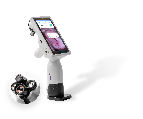Artificial intelligence algorithms hold great promise as a point-of-care cervical cancer diagnostic. The Automatic Visual Evaluation (AVE) algorithm, for example, the AI-based approach to visual cervical cancer screening first publicly identified by the National Cancer Institute of the US and the National Library of Medicine is able to detect precancerous and cancerous lesions based on digital images. Such a test can help end cervical cancer deaths around the world. In order for this technology to reach women everywhere, it needs to be brought out of the laboratory and into the clinic.
MobileODT leads the world in developing clinically usable AVE
MobileODT is uniquely positioned to create the first scalable deployment of AVE technology. The digital EVA System colposcope includes the hardware needed to capture clear high-quality images required for automatic visual evaluation assessment. The device software and parallel secure online portal are a perfect platform on which to run such an AI algorithm. With the EVA System already in use in more than 40 countries, this technology can be deployed to these EVA devices around with world with a simple software update.
The path to deployment
It is a multifaceted journey from the original concept to useable medical diagnostic. MobileODT is honored to be making the journey with partners from around the world. From individual cervical cancer screening programs to some of the world’s most renowned cervical cancer researchers, clinicians from around the world have stepped up to provide the data needed to create a clinically functional form of AI-based cervical cancer screening test. There are multiple overlapping stages to the deployment of such a test:
1. Training an AI algorithm on real-world images
The data used to create AVE came from a 20-year-old study with images captured using obsolete technology. Today’s screening programs require an algorithm designed to be used with images captured on current technology, with the capacity to adapt to any future changes in cervical imaging standards. MobileODT has the largest bank of cervical images in the world. All consistently captured with the EVA System, making it also the most reliable bank of cervical images. MobileODT data scientists applied AVE to MobileODT’s unique dataset as the next step in creating a clinically useful product.
2. Additional layers of algorithm added to adapt to the field environment
In the field, not every clinician takes the same quality images. For an AI-based screening test to be used around the globe, the system must allow for a range of clinician expertise. MobileODT added additional algorithms to ensure that consistent images will be captured to allow for the maximum efficacy of the diagnostic.
3. Testing and verification of AI cervical cancer screening test
To test the newly created matrix of algorithms, retrospective images were needed as a trial data set to see how the algorithm performed. MobileODT was met by an enthusiastic response by our partners, providing retrospective biopsy data as ground truth against which results could be measured. Data has been provided from around the world and runs the gamut of high to low resource settings, including USA, Mexico, Ecuador, Cambodia, Korea, China, Poland, and Nigeria. Using the most rigorous verification standards, MobileODT’s algorithm was both verified and tested with unique datasets ensuring the highest in AI quality control methods.
4. Prospective trials running the AI on the EVA System at the point of care
The efficacy of the MobileODT AI-based cervical cancer screening test can only be conclusively verified by prospective trials conducted on live patients. The first of these trials was completed in Korea with results presented at the 2019 ASCCP annual conference to an enthusiastic response. Large scale trials continue around the world to maintain a breadth of data that allows MobileODT to create a system that will be universally applicable.
5. Regulatory approval
As with any new medical device, relevant regulatory requirements and approval must be fulfilled in those markets that demand them. MobileODT is working with local partners in order to prepare for the initial launch as an adjunct test.
If cervical cancer can be defeated, then over 19 million lives stand to be saved over the next 40 years. With the ability to offer immediate results, allowing clinicians to move directly to the next stage in screening/treatment protocol, AI-based cervical cancer screening is predicted to become the new international gold standard. MobileODT is humbled to be the vehicle for developing the technology for clinical use.
Further reading:
> The FDA approach to AI: Embracing innovation, ensuring safety
> Automated Cervicography Using a Machine Learning Classifier – poster presented ASCCP 2019







